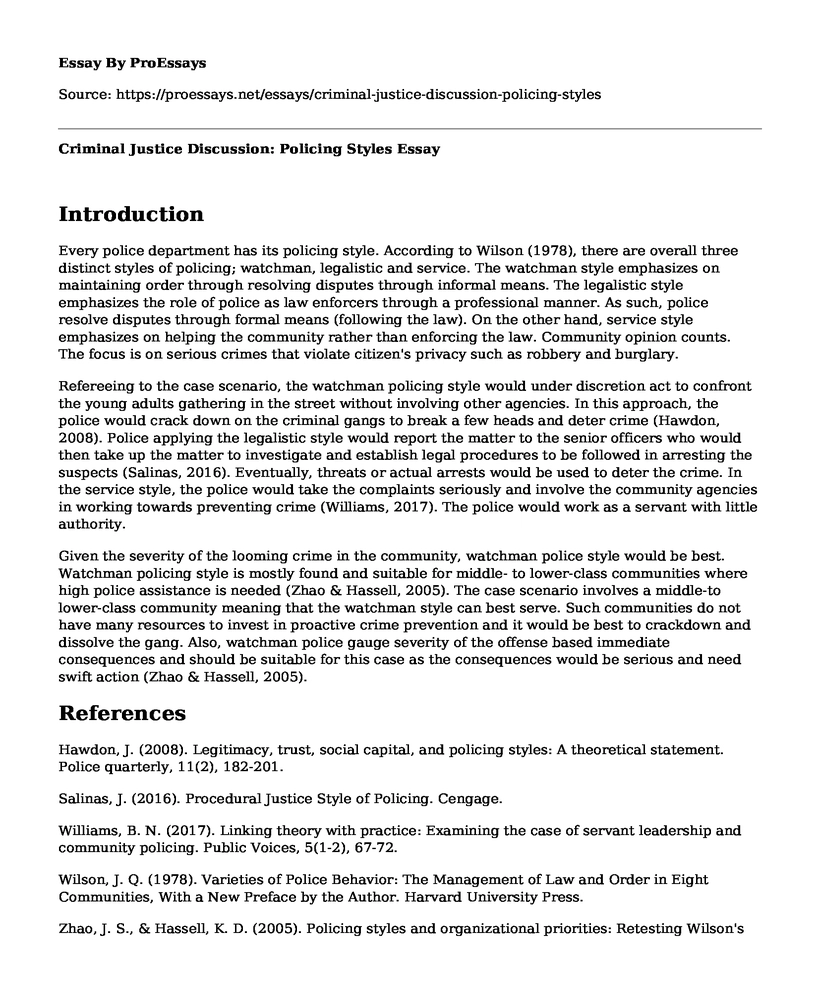Introduction
Every police department has its policing style. According to Wilson (1978), there are overall three distinct styles of policing; watchman, legalistic and service. The watchman style emphasizes on maintaining order through resolving disputes through informal means. The legalistic style emphasizes the role of police as law enforcers through a professional manner. As such, police resolve disputes through formal means (following the law). On the other hand, service style emphasizes on helping the community rather than enforcing the law. Community opinion counts. The focus is on serious crimes that violate citizen's privacy such as robbery and burglary.
Refereeing to the case scenario, the watchman policing style would under discretion act to confront the young adults gathering in the street without involving other agencies. In this approach, the police would crack down on the criminal gangs to break a few heads and deter crime (Hawdon, 2008). Police applying the legalistic style would report the matter to the senior officers who would then take up the matter to investigate and establish legal procedures to be followed in arresting the suspects (Salinas, 2016). Eventually, threats or actual arrests would be used to deter the crime. In the service style, the police would take the complaints seriously and involve the community agencies in working towards preventing crime (Williams, 2017). The police would work as a servant with little authority.
Given the severity of the looming crime in the community, watchman police style would be best. Watchman policing style is mostly found and suitable for middle- to lower-class communities where high police assistance is needed (Zhao & Hassell, 2005). The case scenario involves a middle-to lower-class community meaning that the watchman style can best serve. Such communities do not have many resources to invest in proactive crime prevention and it would be best to crackdown and dissolve the gang. Also, watchman police gauge severity of the offense based immediate consequences and should be suitable for this case as the consequences would be serious and need swift action (Zhao & Hassell, 2005).
References
Hawdon, J. (2008). Legitimacy, trust, social capital, and policing styles: A theoretical statement. Police quarterly, 11(2), 182-201.
Salinas, J. (2016). Procedural Justice Style of Policing. Cengage.
Williams, B. N. (2017). Linking theory with practice: Examining the case of servant leadership and community policing. Public Voices, 5(1-2), 67-72.
Wilson, J. Q. (1978). Varieties of Police Behavior: The Management of Law and Order in Eight Communities, With a New Preface by the Author. Harvard University Press.
Zhao, J. S., & Hassell, K. D. (2005). Policing styles and organizational priorities: Retesting Wilson's theory of local political culture. Police Quarterly, 8(4), 411-430.
Cite this page
Criminal Justice Discussion: Policing Styles. (2022, May 23). Retrieved from https://proessays.net/essays/criminal-justice-discussion-policing-styles
If you are the original author of this essay and no longer wish to have it published on the ProEssays website, please click below to request its removal:
- Law Essay Example: Gilbert Law Summaries on Constitutional Law
- Teachers Should Be Armed - Argumentative Essay
- Essay Sample on Civil and Political Rights
- Public Funds Embezzlement: A Major Criminal Offense - Essay Sample
- Essay Sample on Copyrights Should Not Be Equated With Fundamental Rights of Life and Liberty
- The Legacy of Maggie L. Walker: An Iconic Entrepreneur & Civil Rights Activist - Essay Sample
- Essay on Empowering Maasai Women: The Pastoral Women's Council's Advocacy and Achievements







